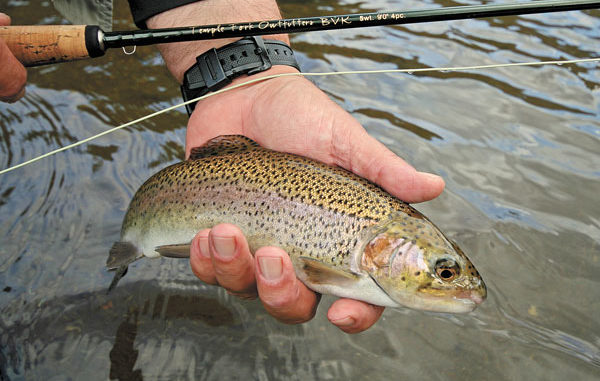
The Chattooga River Trail offers fishermen the chance to pack in and camp along some of the Southeast’s best trout water.
Mention trout fishing in South Carolina and many people will think of speckled seatrout, oyster beds and marsh grass. Seldom thought about are rainbow, brown, and brook trout in a mountain wilderness setting.
But in the northwestern corner of the state, where South Carolina, North Carolina and Georgia all collide, lies one of the south’s most-famous trout-fishing destinations, the wild and scenic Chattooga River.
Because of its notoriety, the Chattooga can, at times, seem crowded. Arrive at one of the more-popular accesses, such as the SC 28 Bridge or Burrells Ford, and the view is often filled with fisherman. But take a little walk, and the scenery changes dramatically.
Approximately 15 miles long, the Chattooga River Trail runs parallel to the best fishing available on the river, and there is no better ways of accessing this water than by packing in and setting up camp. For late summer or early fall, when the temperatures are still fairly warm, Mike Stockton of Chattooga Whitewater Outfitters in Long Creek recommends gear that is light and simple.
“Day-packs or smaller-framed packs that can hold a sleeping bag and small tent are really all most anyone needs for an overnight,” he said.
When packing in, taking several rods is not a good option, but one rod of at least four pieces can easily fit in or on a pack. Changing from fast-moving, shallow riffles and runs to slow, deep pools, the Chattooga requires anglers to change fishing techniques often, and the rod used needs to be able to work for all of the river conditions.
“A 5-weight fly rod is the best choice because it allows you to easily go from fishing small, dry flies to heavier nymphs,” said guide Jonathan Simmons of Chattooga Whitewater Shop in Long Creek.
The Burrells Ford parking lot near the river is an excellent start for fishermen interested in jumping on the trail and packing in. Wild trout dominate the waters upstream, and trout are stocked by the S.C. Department of Natural Resources for several miles downstream of the bridge.
Anglers who do not like to pack their gear in on their backs have the option of staying at one of the walk-in, primitive camp sites at Burrells Ford. Gear will still have to be brought in a little ways from the parking lot, but not so far that items like coolers and larger tents are a problem, especially if a wheelbarrow or wheeled cart is used. Using the walk-in campground as a base camp, smart anglers can get up early and head up or down the trail before the masses start to stir and clutter the scenery.
Hiking along the more-remote parts of the trail, you notice not only the lack of fishermen, but other aspects of the surroundings as well. Hardwoods starting their color change in early fall add to the beauty of the trail, especially when contrasted with the deep colors of the many evergreens. Simmons sums up his love for the Chattooga simply: “Solitude, scenery, and everything from rainbows to redeyes (bass).”
Traveling upstream, a good place to set up camp is near the junction of the East Fork of the Chattooga and the main stem, which only requires a hike of about a mile-and-a-half. At that location, there is a fairly flat area large enough for several different campers to set up without crowding one another. A large, deep pool forms where the East Fork dumps into the main river, and legend has it is home to massive browns, but they did not get that way by being stupid; these fish are difficult to catch and mostly nocturnal.
Plunge pools, pocket water and high, overgrown banks that make casting with a fly rod difficult best describes the East Fork. Taking careful steps and approaching fish-holding spots stealthily, the reward is often some of the brightest-colored and hardest-fighting trout found on the river.
After hiking to the East Fork, hopping across rocks and dodging low-hanging branches, a visual rise to a well-placed classic small-stream dry fly such as a Para Adams or Royal Wulff, can make an angler forget all about the difficulties of getting there.
The main stem both above and below the Burrells Ford bridge fishes more like a big western river than an eastern freestone stream. Averaging more than 100 feet wide in many areas, fly fisherman can really work those arms and get some line out. Flies of choice in the fall are varied, but good choices are mayfly nymph imitations, streamers that imitate sculpins and dace, and both dry and nymph blue-wing olives.
“Basically, there are a ton of bugs, and it really comes down to knowing their behavior and letting that guide you on what pattern to use and how to fish it,” said Jason Galloway of Chattooga River Fly Shop in Mountain Rest.
Containing all three species of trout available to South Carolina anglers, the Chattooga offers a real chance to take a grand slam. Also, bonus species like the redeye bass can add exciting variety to a day on the water. Often, different species will be grouped in different areas, and walking a little ways can reward anglers with a completely different experience.
Of the three species of trout that live in the Chattooga and its feeder streams, the southern brook trout is the only true native of South Carolina. In recent years, there have been efforts by Trout Unlimited to return brookies to the small streams they once inhabited, including Kings Creek, just downstream from the Burrells Ford bridge.
Tight and difficult to fish, these small streams do not seem very appealing to many fly anglers, but for those who love to catch wily fish in a rugged environment, the choice to fish them is a no-brainer. A bonus for exploring is King Creeks Falls, a short walk upstream from where the creek enters the Chattooga. The falls drop about 70 feet into a beautiful pool before becoming a small stream once again down.
For 2.3 miles above the SC 28 bridge, the Chattooga is managed as a delayed-harvest trout stream, with no harvest allowed from November until mid-May. This section can become almost overrun on weekends with anglers attracted by the chance to catch some of the many stocked fish that lie in plain sight.
In these conditions the pack-in angler absolutely has an advantage, because by camping near the river, he can be on the prime spots and fishing by the time most other anglers are just starting the hike in. Also, with a camp nearby, he can stay deep in the delayed-harvest section until the very last bit of daylight is available, after other anglers have headed back to their vehicles.
The charm of fishing the Chattooga River lies not only in the fish that inhabit it, but in the terrain that surrounds it. Also, fly anglers do not have to choose just one type of fishing but can choose anything from a wide river with big fish to small streams with feisty native fish — and everything in-between.

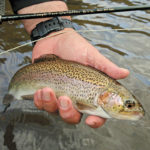
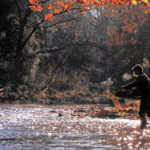
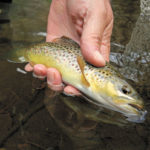
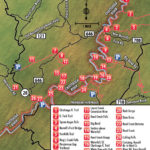
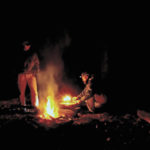
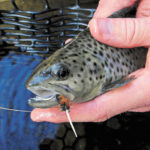
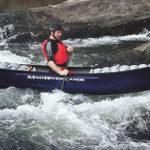


Be the first to comment